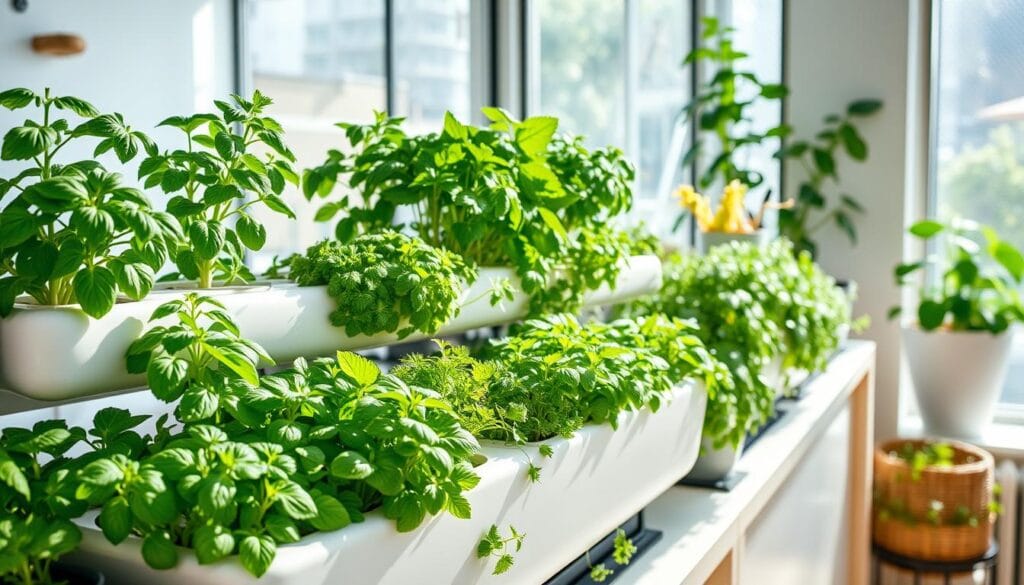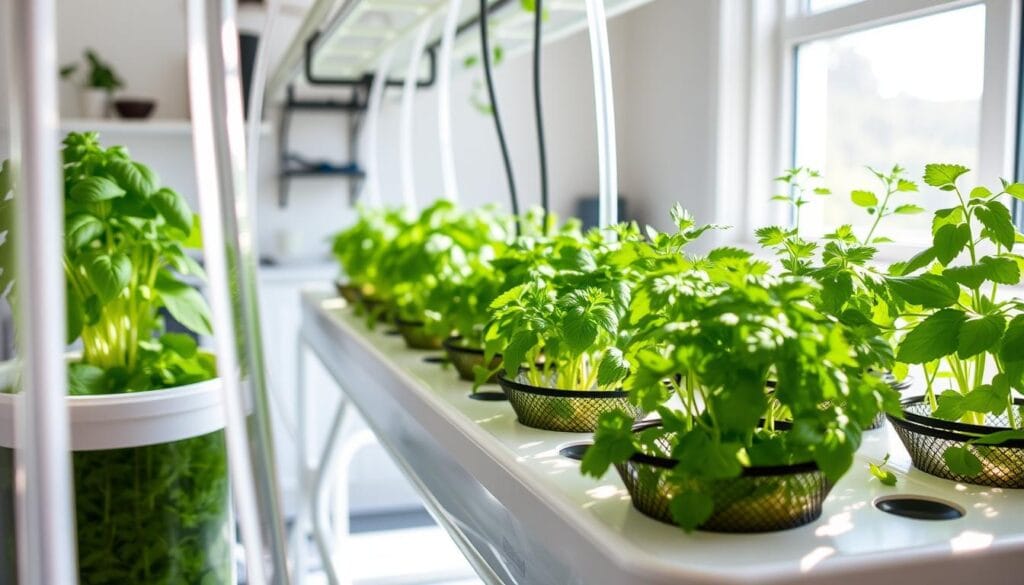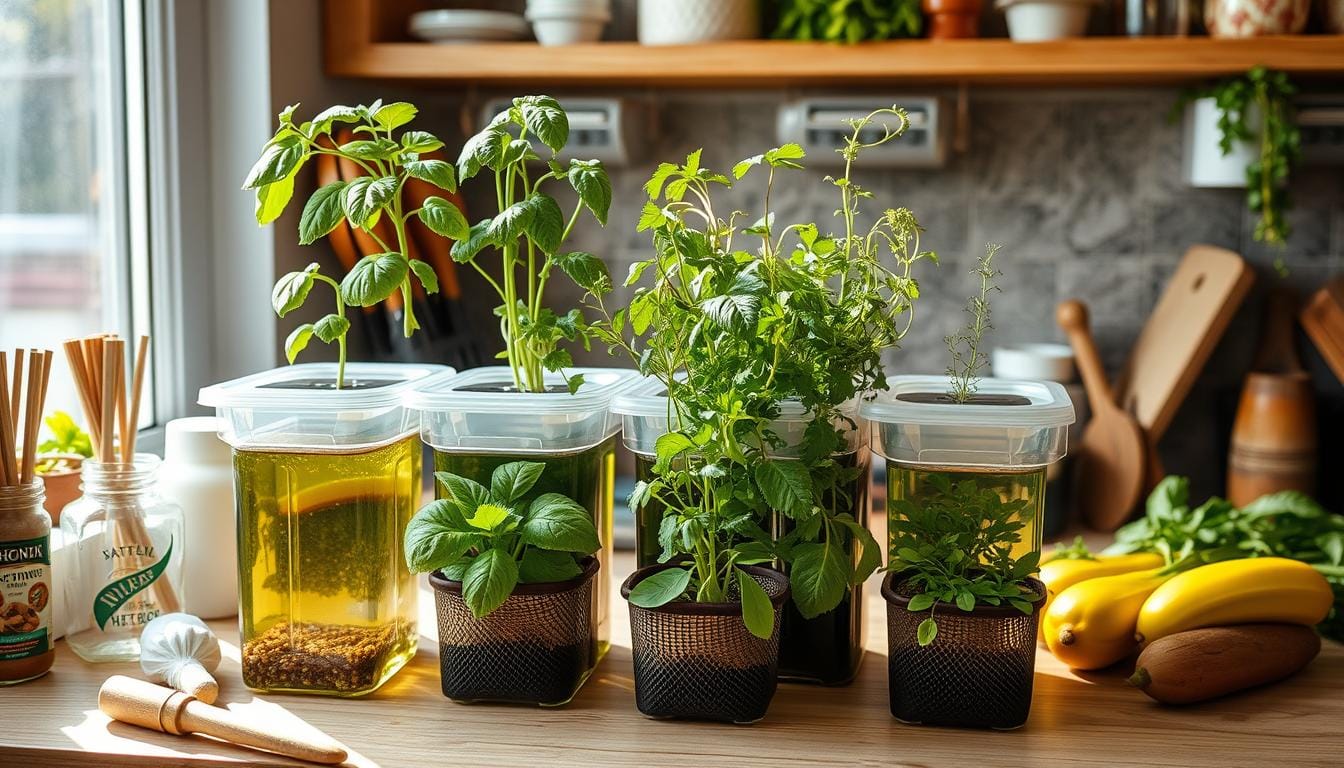Imagine having fresh, flavorful herbs always at hand, no matter the season. A homemade hydroponic system lets you grow your herbs indoors, all year. Hydroponics, growing plants without soil, is great for city folks and garden lovers.
This article will dive into homemade hydroponics. We’ll show you how to build a simple herb garden. You’ll learn about the benefits of soilless growing and different hydroponic systems. You’ll see how to make an indoor garden that gives you fresh herbs anytime.
Key Takeaways
- Discover the advantages of growing herbs using a homemade hydroponic system
- Learn about different hydroponic systems like Aerogarden, Click & Grow, and Gardyn, and their suitability for indoor herb gardening
- Understand the benefits of hydroponic herb gardening, including efficient water usage, year-round growing, and a smaller footprint
- Explore the simplicity of the Kratky method, a low-maintenance approach to hydroponic gardening
- Gain insights into essential components and maintenance requirements for a successful homemade hydro system
Understanding Hydroponics: The Future of Indoor Gardening
Hydroponics lets you grow plants using water instead of soil, delivering nutrients directly for faster growth and efficient space use. It’s changing indoor gardening, and this method is great for growing food in cities and on walls.
Benefits of Soilless Growing
Hydroponics uses a lot less water than regular gardening. It can save up to 90% of water. This is perfect for places where water is scarce.
Plants grown with hydroponics grow faster and produce more. They get nutrients directly and have the right amount of oxygen.
How Hydroponics Works
Hydroponics gives plants nutrients through water. This water is always moving, so plants get what they need. The water also has oxygen for the plants.
Types of Hydroponic Systems
There are many hydroponic systems. Deep Water Culture (DWC) and Kratky method are two examples. They work well for growing food in cities and small spaces.
Hydroponics is efficient and adaptable. It’s a key technology for growing food in a sustainable way, even in tight spaces.
Essential Components for Building a Homemade Hydro System
Building your own hydroponics system at home is rewarding and saves space. You can grow fresh herbs, veggies, and flowers. First, you need a few key parts for a successful system.
Start with a container like a plastic bin or food-grade bucket. It’s where your plants will grow. Make sure it’s opaque or covered to stop algae. Next, pick a growing medium like expanded clay pellets or coco coir for the roots.
- Ebb and flow hydroponic systems are usually larger to allow for a mini floodplain to be created.
- A drip hydroponic system uses thin hoses to deliver water and nutrients directly to plant roots, providing efficient and targeted hydration.
- Deep Water Culture is considered one of the easiest hydroponic systems for beginners.
Nutrient-rich water is vital for your hydroponic system. You’ll need a good hydroponic nutrient solution. This solution gives your plants the minerals and trace elements they need. Keeping the pH between 5.5 and 6.5 is key for nutrient uptake.
| Component | Importance |
|---|---|
| Container | Provides the main growing space and must be opaque or covered to prevent algae growth. |
| Growing Medium | Supports the plant roots and facilitates nutrient and water absorption. |
| Nutrient Solution | Supplies the essential minerals and trace elements needed for plant growth, with a pH between 5.5 and 6.5. |
| Lighting | Provides the necessary light spectrum for photosynthesis, with LED grow lights being a popular choice. |
Good lighting is key for your hydroponics system. LED grow lights are great because they’re energy-efficient and give the right light spectrum. With the right parts, you can have a thriving indoor garden that’s easy to care for and doesn’t take up much space.
The Kratky Method: A Simple Approach to Hydroponics
Explore the Kratky method, a simple way to grow plants indoors. It’s a passive hydroponics method that’s easy to use. You don’t need air pumps or electricity, making it perfect for beginners.
Basic Principles of Kratky Method
The Kratky method uses a closed-loop system. Plants sit above a nutrient-rich solution with a 3-4 cm gap for oxygen. As plants use the solution, the water level goes down. This creates an air gap for roots to get oxygen and water.
Setting Up Your First Kratky System
- Choose a container like a plastic bin or glass jar. Make the nutrient solution as the instructions say.
- Put the plants above the solution, making sure roots are in water but leaves aren’t.
- Put a cover on to stop algae and keep the water level right.
Maintaining Proper Water Levels
It’s important to check and adjust the water level often. As plants use the solution, the water level drops. Keep a 3-4 cm air gap for oxygen. Add fresh solution as needed, without getting the leaves wet.
Using the Kratky method lets you enjoy passive hydroponics and low-maintenance growing at home. It’s a simple way to grow fresh herbs, greens, and veggies indoors.
Choosing the Right Plants for Your Indoor Garden
Starting an indoor herb garden or growing vegetables indoors is rewarding. You get to enjoy fresh, tasty food all year. When picking plants for your hydroponic setup, think about how fast they grow, what nutrients they need, and how much space they take up. Let’s look at some top picks that do well indoors.
Leafy greens like arugula, buttercrunch lettuce, and bibb lettuce are great for indoor gardens. They grow quickly, taking 25-60 days to be ready. Herbs like basil, parsley, and cilantro also do well, taking 55-75 days to mature.
For more variety, try Swiss chard, spinach, and green onions. Swiss chard takes 60-65 days to grow, while spinach is ready in 28-55 days. Green onions can be picked several times after they first grow.
| Plant Type | Maturity Time (Days) |
|---|---|
| Lettuce | 25-60 |
| Spinach | 28-55 |
| Swiss Chard | 60-65 |
| Arugula | 40-45 |
| Basil | 65-70 |
| Parsley | 60-75 |
| Cilantro | 55-75 |
When picking plants for your herb garden or vegetable cultivation indoors, think about each plant’s needs and how it grows. Systems like Nutrient Film Technique (NFT), Deep Water Culture (DWC), and Ebb and Flow can grow many plants. This makes it easy to create a vibrant indoor garden that fits your space and taste.

Smart Monitoring Solutions for Your Hydroponic Garden
Starting a smart garden is exciting. Adding environmental monitoring tools can really help. These tools use advanced sensors and data to keep your plants healthy and growing well.
Environmental Sensors and Controls
Use sensors like the BME680 to track important things like temperature, humidity, and gas levels. This info helps you know how your plants are doing. You can then adjust things to keep your garden perfect for growing.
Don’t forget about automated pH controllers. They keep the nutrient solution’s pH just right, which is good for your plants. Also, automated dosing systems make sure your plants get the right amount of nutrients all the time.
Data Collection and Analysis
Use tools to log and analyze data from your smart garden. Services like Viam’s Data Management Service can help you understand what your sensors are telling you. This way, you can make smart choices to help your plants grow.
Looking at the data helps you spot trends and problems. You can then make changes to your hydroponic system. This keeps your plants happy and healthy.
Remote Monitoring Setup
Set up a system with a Raspberry Pi, sensors, and a webcam for remote monitoring. This lets you check on your hydroponic garden from anywhere. You can see how things are going and even control some parts of your system from afar.
Discover the power of smart garden tech. It makes your indoor hydroponic garden more efficient and productive. With precision and data, you can grow amazing plants indoors.
| Brand | Price | Warranty | Key Features |
|---|---|---|---|
| Rise Gardens | $349.00 | 1-year | Automated lighting, nutrient delivery, and ventilation |
| Lettuce Grow | $699.00 | 90-day return policy | Precision pH control and nutrient dosing |
| Gardyn | $899.00 | 1-year limited warranty | Hybriponics™ Technology for 95% water savings |
| Click & Grow | $99.95 | 1-year | Wide range of indoor garden models with smart features |
| Aerogarden | $59.95 | 1-year limited warranty | Accommodates 3 to 30 plants, with vacation mode and Wi-Fi |
Nutrient Management and pH Balance
Keeping the right hydroponic nutrients and pH monitoring is key for a successful indoor garden. Knowing the correct nutrient levels and pH balance is crucial for plant health and growth.
Choosing the right fertilizers is important for nutrient management. Fertilizers like calcium nitrate, ammonium nitrate, and magnesium sulfate have different nutrient profiles. It’s vital to mix a balanced nutrient solution that gives your plants all the necessary nutrients.
Checking the Electrical Conductivity (EC) of your nutrient solution is also crucial. The EC level affects how well your plants can use essential nutrients. Keeping the EC in the right range helps prevent nutrient deficiencies or toxicities.
pH monitoring is another critical factor. The pH level of your solution affects how minerals are available to your plants. Keeping the pH between 5.5 and 6.5 is essential for plant health and growth.
| Nutrient | Concentration (ppm) |
|---|---|
| Nitrogen (N) | 150 |
| Phosphorus (P) | 31 |
| Potassium (K) | 210 |
Using precision tools like pH and EC meters helps you monitor and adjust your solution. By managing your hydroponic nutrients and pH monitoring well, you can create a perfect environment for your plants. This will help them thrive and give you a great harvest.
Best Practices for Seed Germination and Transplanting
Getting seeds to germinate and transplanting them smoothly is key to a thriving hydroponic garden. By following the best practices, you can make sure your plants grow well. This includes creating the right conditions and a smooth move from seed to hydroponic system.
Creating Optimal Growing Conditions
Temperature and humidity are crucial for seed germination. Keep the temperature between 70-85°F (21-29°C) and humidity at 70-90%. Use a damp paper towel and a Ziploc bag to mimic these conditions. This helps the seeds sprout before you transplant them.
Start with inert media like rockwool, coconut coir, or a mix of peat and perlite. Soak the media well before planting the seeds half an inch deep. Cover the tray to keep out light until the seeds germinate, usually in 3-5 days.
Moving Plants to the Hydroponic System
When your seeds sprout, it’s time to move them to the hydroponic system. Carefully remove the seedlings from their germination media without harming the roots. Transplanting techniques like the Kratky method or Nutrient Film Technique (NFT) help with a smooth transition.
Make sure your hydroponic system is ready with the right nutrient solution and water levels before adding the transplants. Watch the plants closely in the first few days. Adjust the water level and air circulation as needed to support their growth and seed starting in the new environment.
“Starting seeds hydroponically allows for easier transplantation into larger systems, with faster growth compared to soil germination.”
Common Challenges and Troubleshooting Tips
Starting a hydroponic garden is rewarding, but it comes with challenges. You’ll face hydroponic problems and need plant care solutions to solve them.
Nutrient deficiencies are a common issue. Your plants might grow slowly, change color, or wilt. Testing pH and nutrient levels helps fix these problems quickly.
- Keep pH between 5.5 and 6.5 for best nutrient uptake.
- Add specific nutrients to the solution as needed.
- Change the solution if it’s old or contaminated.
Root rot is another big problem. It can be caused by bad water flow, stale water, or bacteria. Fixing root rot fast is key to keeping your plants healthy.
- Check for root color changes or sliminess often.
- Ensure good water flow and air to prevent stagnation.
- Use hydrogen peroxide or beneficial bacteria to fight root rot.
Pests can also be a problem in hydroponic gardens. Even though it’s a controlled space, pests can still get in. Watch closely and use natural pest control to keep them away.
“The key to successful hydroponic gardening is being proactive and addressing problems before they escalate.”
Stay informed and ready to tackle hydroponic problems. With some troubleshooting and the right plant care solutions, your hydro system will flourish. It will give you a great harvest.

Maintenance and Long-term System Care
Keeping your homemade hydroponic system in top shape is key for a healthy indoor garden. It’s important to clean regularly and keep the system running well. This ensures your hydroponic maintenance and system longevity.
Regular Cleaning Procedures
Stopping algae growth and keeping a clean space for your plants is vital. Drain the reservoir, clean the inside, and disinfect everything. Make sure the pump is working right.
Keep the grow tent or room clean by disinfecting surfaces, pots, and tools. Good lighting, ventilation, and air flow are also crucial for a healthy growing area.
System Optimization Over Time
As your hydroponic garden grows, watch and adjust nutrient levels, pH, and environment. Check the electrical conductivity (EC) and pH levels to meet your plants’ needs. Update parts like filters or grow lights to boost efficiency.
Prune and care for your plants to promote healthy growth and high yields. By focusing on hydroponic maintenance and system longevity, your homemade hydro system will thrive for years.
Conclusion
In this article, we’ve looked into the world of homemade hydroponic systems and indoor gardening. This method lets you grow food without soil, giving you fresh herbs, veggies, and fruits all year. It’s a way to produce food sustainably.
Creating your own hydroponic system is a fun and learning experience. You can start with a simple setup or go for something more complex. Learning about plants, nutrients, and solving problems is part of the journey.
The hydroponic market is growing fast. This is because more people want to grow food in a sustainable way and enjoy indoor gardening. Now is a great time to start your hydroponic project. With some knowledge and practice, you can make your home a place of fresh, tasty food. Start your journey to a self-sufficient home with sustainable food production and indoor gardening benefits today.

